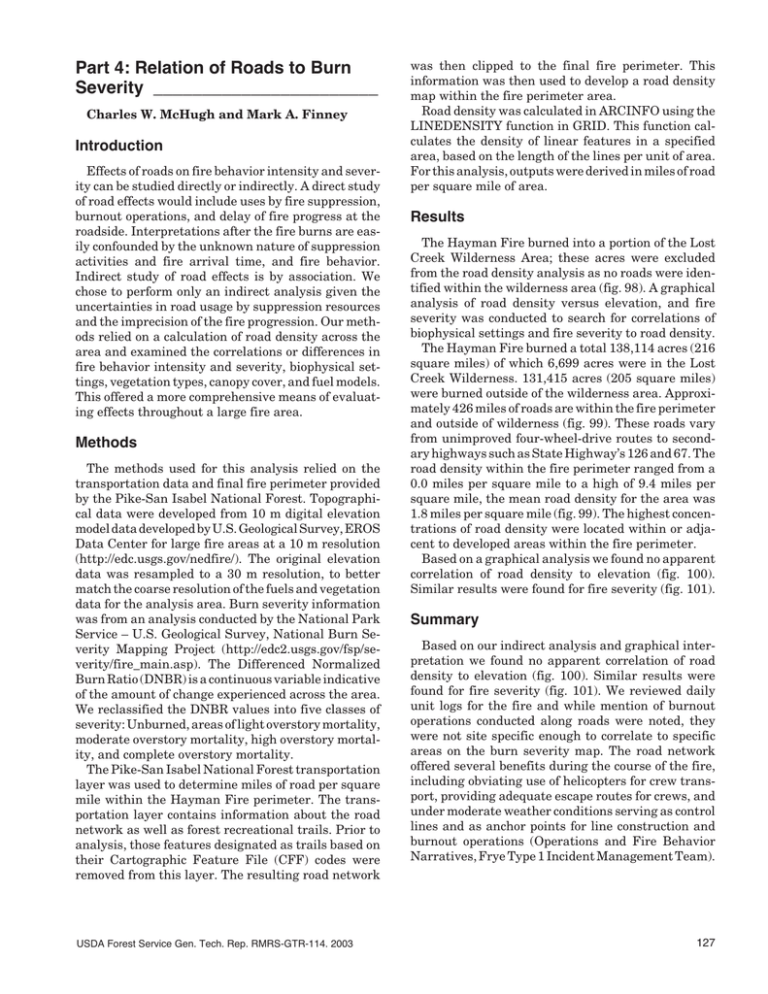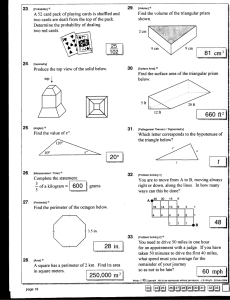Part 4: Relation of Roads to Burn
advertisement

Part 4: Relation of Roads to Burn Severity _______________________ Charles W. McHugh and Mark A. Finney Introduction Effects of roads on fire behavior intensity and severity can be studied directly or indirectly. A direct study of road effects would include uses by fire suppression, burnout operations, and delay of fire progress at the roadside. Interpretations after the fire burns are easily confounded by the unknown nature of suppression activities and fire arrival time, and fire behavior. Indirect study of road effects is by association. We chose to perform only an indirect analysis given the uncertainties in road usage by suppression resources and the imprecision of the fire progression. Our methods relied on a calculation of road density across the area and examined the correlations or differences in fire behavior intensity and severity, biophysical settings, vegetation types, canopy cover, and fuel models. This offered a more comprehensive means of evaluating effects throughout a large fire area. Methods The methods used for this analysis relied on the transportation data and final fire perimeter provided by the Pike-San Isabel National Forest. Topographical data were developed from 10 m digital elevation model data developed by U.S. Geological Survey, EROS Data Center for large fire areas at a 10 m resolution (http://edc.usgs.gov/nedfire/). The original elevation data was resampled to a 30 m resolution, to better match the coarse resolution of the fuels and vegetation data for the analysis area. Burn severity information was from an analysis conducted by the National Park Service – U.S. Geological Survey, National Burn Severity Mapping Project (http://edc2.usgs.gov/fsp/severity/fire_main.asp). The Differenced Normalized Burn Ratio (DNBR) is a continuous variable indicative of the amount of change experienced across the area. We reclassified the DNBR values into five classes of severity: Unburned, areas of light overstory mortality, moderate overstory mortality, high overstory mortality, and complete overstory mortality. The Pike-San Isabel National Forest transportation layer was used to determine miles of road per square mile within the Hayman Fire perimeter. The transportation layer contains information about the road network as well as forest recreational trails. Prior to analysis, those features designated as trails based on their Cartographic Feature File (CFF) codes were removed from this layer. The resulting road network USDA Forest Service Gen. Tech. Rep. RMRS-GTR-114. 2003 was then clipped to the final fire perimeter. This information was then used to develop a road density map within the fire perimeter area. Road density was calculated in ARCINFO using the LINEDENSITY function in GRID. This function calculates the density of linear features in a specified area, based on the length of the lines per unit of area. For this analysis, outputs were derived in miles of road per square mile of area. Results The Hayman Fire burned into a portion of the Lost Creek Wilderness Area; these acres were excluded from the road density analysis as no roads were identified within the wilderness area (fig. 98). A graphical analysis of road density versus elevation, and fire severity was conducted to search for correlations of biophysical settings and fire severity to road density. The Hayman Fire burned a total 138,114 acres (216 square miles) of which 6,699 acres were in the Lost Creek Wilderness. 131,415 acres (205 square miles) were burned outside of the wilderness area. Approximately 426 miles of roads are within the fire perimeter and outside of wilderness (fig. 99). These roads vary from unimproved four-wheel-drive routes to secondary highways such as State Highway’s 126 and 67. The road density within the fire perimeter ranged from a 0.0 miles per square mile to a high of 9.4 miles per square mile, the mean road density for the area was 1.8 miles per square mile (fig. 99). The highest concentrations of road density were located within or adjacent to developed areas within the fire perimeter. Based on a graphical analysis we found no apparent correlation of road density to elevation (fig. 100). Similar results were found for fire severity (fig. 101). Summary Based on our indirect analysis and graphical interpretation we found no apparent correlation of road density to elevation (fig. 100). Similar results were found for fire severity (fig. 101). We reviewed daily unit logs for the fire and while mention of burnout operations conducted along roads were noted, they were not site specific enough to correlate to specific areas on the burn severity map. The road network offered several benefits during the course of the fire, including obviating use of helicopters for crew transport, providing adequate escape routes for crews, and under moderate weather conditions serving as control lines and as anchor points for line construction and burnout operations (Operations and Fire Behavior Narratives, Frye Type 1 Incident Management Team). 127 Figure 98—Road network within the Hayman Fire perimeter. 128 USDA Forest Service Gen. Tech. Rep. RMRS-GTR-114. 2003 Figure 99—Road density (miles) summarized per 1 square mile. USDA Forest Service Gen. Tech. Rep. RMRS-GTR-114. 2003 129 Figure 100—Plot of burn severity against road density suggests no relationship. Figure 101—Plot of burn elevation against density suggests no relationship. 130 USDA Forest Service Gen. Tech. Rep. RMRS-GTR-114. 2003





